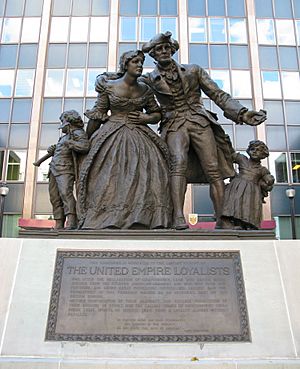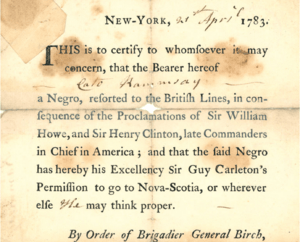Deborah Squash facts for kids

Deborah Squash was born around 1763. She was an enslaved person on George Washington's Mount Vernon farm. In 1781, she bravely escaped. She traveled to New Amsterdam, which was where the British army was based during the American Revolution. When the war ended, Deborah was one of 3,000 Black people listed in the Book of Negroes. They sailed on British ships to Nova Scotia to start new lives.
Contents
Life at Mount Vernon
Deborah grew up enslaved on George and Martha Washington's large farm, called Mount Vernon. The Washingtons owned about 300 enslaved people. These people were forced to work very hard. The enslaved workers at Mount Vernon were known for their "highly developed skills." They were seen as "valuable property" by their owners.
During the American Revolutionary War, George Washington needed money badly. He thought about selling some of the enslaved people. He especially considered selling single people to avoid splitting up families. Enslaved African-Americans at Mount Vernon knew they could be sold at any time. In 1779, nine people were sold. Washington even asked his cousin, Lund Washington, to find good prices for the remaining single enslaved people.
Promises of Freedom
During the American Revolutionary War, important promises were made. In 1775, Lord Dunmore, the British governor of Virginia, made a special announcement. He said that enslaved people who left their owners and joined the British Army would become free.
Later, in 1779, Sir Henry Clinton was the British Commander-in-chief in New York. He realized the British were losing the war. So, he made another announcement called the Philipsburg Proclamation. This promise said that any Black person who supported the British would get freedom, protection, and land. These promises gave many enslaved people hope for a new life.
Escape to New York
Deborah was 16 years old in April 1781. She saw her chance to escape when the British ship HMS Savage came close to Mount Vernon. The ship was sailing along the Potomac River, taking things and setting houses on fire. Leaving Mount Vernon was a huge risk for Deborah. She hoped the British would keep their promise of freedom. She also hoped she could find a job to support herself.
Deborah and sixteen other enslaved people, all single, ran to board the ship. Lund Washington, George Washington's cousin and the farm manager, tried to get them back. He offered supplies to the ship's captain, Thomas Graves. The captain took the supplies but did not release the people. Deborah and the others joined thousands of runaways who followed the British Army. The British were not ready to feed and care for so many people. Many historians believe that almost half of the people who followed the British Army died. They died from sickness, hunger, or cold weather before the war ended.
Deborah survived, even though she caught smallpox. The disease left marks on her face. She made her way to New Amsterdam, which was the main base for the British army. Henry Squash, another enslaved person who had escaped, also came to New Amsterdam. He was sold by a British captain to a Mr. Lynch. Henry and Deborah later got married.
Journey to Nova Scotia
The war ended in 1783. The Treaty of Paris said that the British should return all escaped enslaved people. But Guy Carleton, who was in charge of moving British forces out of the colonies, worried about how these Black people would be treated if they went back to their owners. He refused to send them back. Instead, he offered money for each runaway, and George Washington accepted this.
The Book of Negroes was a list of every Black person who boarded a British ship in New York. Deborah was listed as being about 20 years old and married to Henry. It said she was believed to have escaped four years earlier. She received her certificate of freedom from General Samuel Birch.
On April 27, 1783, Deborah and Henry boarded a ship called Polly. They sailed to Port Roseway, Nova Scotia. Deborah just barely avoided being sent back to Mount Vernon. The very next day, George Washington wrote to the officer in New York. He asked him to hold any of his enslaved people who might be trying to leave. But Deborah was already gone.
Life in Nova Scotia
Deborah arrived at Port Roseway, but the people in Canada were not ready for so many new arrivals. Many people first lived in temporary homes like tents or small huts. They had been promised land, but most Black Loyalists did not receive any. If they did get land, it was often not good for farming.
If a Black person had a skill, they could work in a trade. However, they were paid less than white people for the same work. Those without a trade often became indentured servants, which meant they were treated almost like enslaved people. Slavery was still legal in Nova Scotia at that time.
In July 1784, a group of former white soldiers started Canada's first race riot. They were angry that Black people were paid less and had more customers. They destroyed the homes of 20 Black people in Port Roseway (now Shelburne). Many Black people died from illness, poverty, hunger, and harsh winters. Despite these difficulties, Black Loyalists found comfort in religion and spiritual songs. They were able to worship freely.
About a year after arriving in Port Roseway, Deborah settled in Birchtown, Nova Scotia. She is listed in the Birchtown Muster of 1784. By this time, she was no longer with Henry Squash, who is thought to have died. She is listed as Deborah Lynch, living in a house with a Mr. Lynch. In the same house was Neil Robinson, who is believed to have changed his name from Jack Neal.
About 1,500 Black Loyalists settled in Shelburne County, Nova Scotia. Most settled in Port Roseway, and some settled in Birchtown. Birchtown was named after General Samuel Birch. Colonel Stephen Blucke, a Black Loyalist, led the Black Pioneers in building the towns of Port Roseway and Birchtown.
Legacy
Deborah Squash's life story, and what it was like to be an enslaved person, was shared in a book called "Slavery in New York." This book later became part of an exhibit in New York City.



